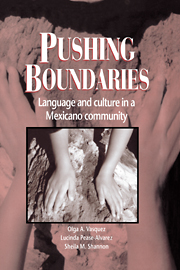Book contents
- Frontmatter
- Contents
- Foreword
- Preface
- Chapter 1 INTRODUCTION
- Chapter 2 EASTSIDE: A MEXICANO COMMUNITY
- Chapter 3 HOME AND SCHOOL CONTEXTS FOR LANGUAGE LEARNING
- Chapter 4 BILINGUAL CHILDREN CROSSING CULTURAL BORDERS
- Chapter 5 NEGOTIATING CULTURE AND LANGUAGE IN THE HOME
- Chapter 6 MOVING TOWARD A RECOGNITION PERSPECTIVE
- Chapter 7 MEETING THE CHALLENGES OF DIVERSITY
- Notes
- References
- Index
Chapter 2 - EASTSIDE: A MEXICANO COMMUNITY
Published online by Cambridge University Press: 26 March 2010
- Frontmatter
- Contents
- Foreword
- Preface
- Chapter 1 INTRODUCTION
- Chapter 2 EASTSIDE: A MEXICANO COMMUNITY
- Chapter 3 HOME AND SCHOOL CONTEXTS FOR LANGUAGE LEARNING
- Chapter 4 BILINGUAL CHILDREN CROSSING CULTURAL BORDERS
- Chapter 5 NEGOTIATING CULTURE AND LANGUAGE IN THE HOME
- Chapter 6 MOVING TOWARD A RECOGNITION PERSPECTIVE
- Chapter 7 MEETING THE CHALLENGES OF DIVERSITY
- Notes
- References
- Index
Summary
The San Francisco Bay Area reaches 50 miles south into the fertile farming valleys of northern California. From San Francisco to San Jose on both sides of the bay, towns, cities, and subdivisions roll one upon another to form a seamless string of lights and sounds. Lincoln City lies in the center of the San Francisco peninsula. The community of Mexican immigrants that informs this book is part of an ethnic enclave located in roughly one square mile of unincorporated land that lies on Lincoln City's east side (see Figure 1). The east side is bounded by three major thoroughfares and the walled estates of the affluent city of Concord. Physically and socially, the east side stands visibly apart from the rest of Lincoln City. Not only does the social scene change from private to public as one comes into Lincoln City from Concord, but the language and physical characteristics of the residents change as well. The presence of the Mexicano community is obvious: The streets of the east side are alive with commercial and social activity in which the use of Spanish, both spoken and written, is as common as the use of English. Evidence of Mexican culture is easily discernible throughout the area in ways of dress, talk, and leisure. Although Lincoln City is more than 500 miles north of the U.S. and Mexican border, the commercial life of the east side looks remarkably similar to that of the Mexicano neighborhoods in such cities as Los Angeles, EI Paso, or Tucson.
- Type
- Chapter
- Information
- Pushing BoundariesLanguage and Culture in a Mexicano Community, pp. 19 - 45Publisher: Cambridge University PressPrint publication year: 1994



